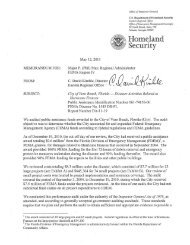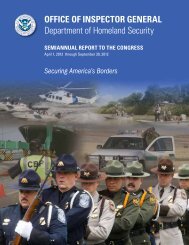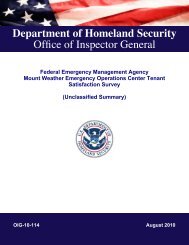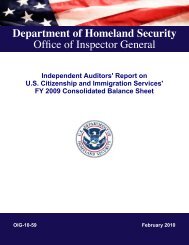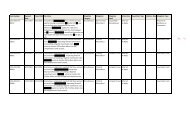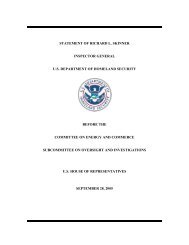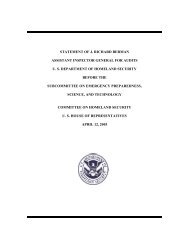Audit of the Effectiveness of the Checked Baggage Screening ...
Audit of the Effectiveness of the Checked Baggage Screening ...
Audit of the Effectiveness of the Checked Baggage Screening ...
Create successful ePaper yourself
Turn your PDF publications into a flip-book with our unique Google optimized e-Paper software.
Department <strong>of</strong> Homeland Security<br />
Office <strong>of</strong> Inspector General<br />
<strong>Audit</strong> <strong>of</strong> <strong>the</strong> <strong>Effectiveness</strong> <strong>of</strong> <strong>the</strong> <br />
<strong>Checked</strong> <strong>Baggage</strong> <strong>Screening</strong> System and Procedures <br />
Used to Identify and Resolve Threats <br />
(Unclassified Summary)<br />
OIG-09-42 March 2009
Office <strong>of</strong> Inspector General<br />
U.S. Department <strong>of</strong> Homeland Security<br />
Washington, DC 20528<br />
March 17, 2009<br />
Preface<br />
The Department <strong>of</strong> Homeland Security (DHS) Office <strong>of</strong> Inspector General (OIG) was<br />
established by <strong>the</strong> Homeland Security Act <strong>of</strong> 2002 (Public Law 107-296) by amendment<br />
to <strong>the</strong> Inspector General Act <strong>of</strong> 1978. This is one <strong>of</strong> a series <strong>of</strong> audit, inspection, and<br />
special reports prepared as part <strong>of</strong> our oversight responsibilities to promote economy,<br />
efficiency, and effectiveness within <strong>the</strong> department.<br />
This report addresses <strong>the</strong> strengths and weaknesses <strong>of</strong> <strong>the</strong> Transportation Security<br />
Administration’s procedures, equipment, and supervision to ensure that Transportation<br />
Security Officers are able to prevent threat items from being introduced into <strong>the</strong> checked<br />
baggage systems <strong>of</strong> <strong>the</strong> nation’s airports. It is based on interviews with Transportation<br />
Security Officers and Transportation Security Administration <strong>of</strong>ficials, direct<br />
observations, field testing, and a review <strong>of</strong> applicable documents.<br />
The recommendations herein have been developed to <strong>the</strong> best knowledge available to our<br />
<strong>of</strong>fice, and have been discussed in draft with those responsible for implementation. We<br />
trust this report will result in more effective, efficient, and economical operations. We<br />
express our appreciation to all <strong>of</strong> those who contributed to <strong>the</strong> preparation <strong>of</strong> this report.<br />
Richard L. Skinner <br />
Inspector General
OIG<br />
Department <strong>of</strong> Homeland Security<br />
Office <strong>of</strong> Inspector General<br />
Background<br />
The Transportation Security Administration (TSA) is responsible<br />
for overseeing aviation security and ensuring <strong>the</strong> safety <strong>of</strong> <strong>the</strong> air<br />
traveling public. This includes <strong>the</strong> screening <strong>of</strong> checked baggage<br />
and safeguarding it from prohibited items. We conducted<br />
unannounced, covert testing to evaluate how effective <strong>the</strong> On-<br />
Screen Alarm Resolution Protocol (OSARP) certified operators are<br />
at determining whe<strong>the</strong>r an object causing an explosives detection<br />
system to alarm poses a serious threat and how those threats are<br />
being resolved.<br />
We conducted unannounced, covert testing at eight domestic<br />
airports, from April 2008 through June 2008. Because TSA has<br />
deployed explosives trace detection machines at most <strong>of</strong> <strong>the</strong> major<br />
domestic airports for operational use, we included locations that<br />
were using <strong>the</strong>se technologies in conjunction with trained<br />
Transportation Security Officers (TSOs) utilizing <strong>the</strong> OSARP<br />
when we made our airport selections.<br />
Our purpose in testing was to determine whe<strong>the</strong>r: (1) TSA’s<br />
implementation <strong>of</strong> OSARP is effective; (2) TSA’s checked<br />
baggage screening procedures and standards are adequate;<br />
(3) TSOs are following those screening procedures and standards;<br />
and (4) aviation security screening equipment and technologies are<br />
functioning properly and as intended to prevent threat items from<br />
entering <strong>the</strong> checked baggage system.<br />
<strong>Audit</strong> <strong>of</strong> <strong>the</strong> <strong>Effectiveness</strong> <strong>of</strong> <strong>the</strong> <strong>Checked</strong> <strong>Baggage</strong> <strong>Screening</strong> System and Procedures Used to Identify and Resolve Threats<br />
Page 1
Results <strong>of</strong> <strong>Audit</strong><br />
TSA’s Response<br />
The number <strong>of</strong> tests conducted, <strong>the</strong> names <strong>of</strong> <strong>the</strong> airports tested,<br />
and <strong>the</strong> quantitative and qualitative results <strong>of</strong> our testing are<br />
classified. We have shared that information with <strong>the</strong> department,<br />
<strong>the</strong> Transportation Security Administration, and appropriate<br />
congressional committees.<br />
We identified vulnerabilities in <strong>the</strong> security <strong>of</strong> checked baggage at<br />
<strong>the</strong> eight domestic airports where we conducted testing. As a<br />
result <strong>of</strong> our testing, we made four recommendations. TSA<br />
concurred with three <strong>of</strong> <strong>the</strong> four recommendations and concurred<br />
in part with <strong>the</strong> o<strong>the</strong>r recommendation. When fully implemented,<br />
<strong>the</strong>se recommendations should streng<strong>the</strong>n <strong>the</strong> checked baggage<br />
screening process.<br />
We gave a copy <strong>of</strong> our draft report to TSA for review and<br />
comment. The unclassified portion <strong>of</strong> TSA’s response to our draft<br />
report is summarized below.<br />
TSA appreciates <strong>the</strong> work done by OIG on this engagement, and<br />
can generally validate OIG’s data against TSA’s own covert<br />
testing programs when TSA analysis rules are applied. While we<br />
disagree over OIG’s characterizations <strong>of</strong> Explosives Detection<br />
System (EDS) performance and have excluded <strong>the</strong>m from our<br />
analysis, <strong>the</strong> remainder <strong>of</strong> OIG’s data is in line with TSA test<br />
results in both agency-run covert testing programs.<br />
OIG’s data continues to demonstrate <strong>the</strong> effectiveness <strong>of</strong> TSA’s<br />
checked baggage security system in detecting and removing threat<br />
objects.<br />
TSA Covert Assessment Programs Have Similar Results<br />
Aviation <strong>Screening</strong> Assessment Program<br />
TSA’s Aviation <strong>Screening</strong> Assessment Program (ASAP) is<br />
designed to measure screening performance using a realistic<br />
standardized test scenario framework. Through ASAP, TSA<br />
conducts covert testing <strong>of</strong> <strong>the</strong> TSA screening process. The primary<br />
purpose is to provide statistical data to identify points <strong>of</strong> and<br />
reasons for failures within <strong>the</strong> checkpoint and checked baggage<br />
screening process. The data generated from ASAP testing is used<br />
<strong>Audit</strong> <strong>of</strong> <strong>the</strong> <strong>Effectiveness</strong> <strong>of</strong> <strong>the</strong> <strong>Checked</strong> <strong>Baggage</strong> <strong>Screening</strong> System and Procedures Used to Identify and Resolve Threats<br />
Page 2
to make national recommendations to improve screening<br />
performance.<br />
TSA Office <strong>of</strong> Inspection Testing<br />
TSA’s Office <strong>of</strong> Inspection has a very robust testing program<br />
designed to identify systemic vulnerabilities in transportation<br />
security systems. Through <strong>the</strong> Office <strong>of</strong> Inspection testing<br />
program, subject matter experts develop and test specific<br />
hypo<strong>the</strong>ses regarding potential system vulnerabilities. These tests<br />
are not designed to be performance measures. Ra<strong>the</strong>r, <strong>the</strong>y are<br />
evaluations <strong>of</strong> system vulnerabilities that can be used to design<br />
countermeasures. When viewed in this light, <strong>the</strong> qualitative results<br />
from <strong>the</strong>se experiments are highly valuable in analyzing<br />
vulnerabilities, with conclusions from <strong>the</strong>se experiments informing<br />
decisions at <strong>the</strong> strategic level.<br />
TSA appreciates <strong>the</strong> work done by OIG on this engagement, which<br />
fur<strong>the</strong>r validates TSA’s own testing <strong>of</strong> <strong>the</strong> checked baggage<br />
screening system effectiveness.<br />
<strong>Audit</strong> <strong>of</strong> <strong>the</strong> <strong>Effectiveness</strong> <strong>of</strong> <strong>the</strong> <strong>Checked</strong> <strong>Baggage</strong> <strong>Screening</strong> System and Procedures Used to Identify and Resolve Threats<br />
Page 3
Appendix A<br />
Major Contributors to this Report<br />
Patrick O’Malley, Director, Transportation Security Division<br />
James Yeager, Program Manager<br />
Cecilia Barela, Analyst-in-Charge<br />
Sharon Trodden, Senior <strong>Audit</strong>or<br />
Danielle de Sanctis, Program Analyst<br />
Barry Cleveland, Program Analyst<br />
Vanessa Santos, Independent Referencer<br />
<strong>Audit</strong> <strong>of</strong> <strong>the</strong> <strong>Effectiveness</strong> <strong>of</strong> <strong>the</strong> <strong>Checked</strong> <strong>Baggage</strong> <strong>Screening</strong> System and Procedures Used to Identify and Resolve Threats<br />
Page 4
Appendix B<br />
Report Distribution<br />
Department <strong>of</strong> Homeland Security<br />
Secretary<br />
Acting Deputy Secretary<br />
Chief <strong>of</strong> Staff for Operations<br />
Chief <strong>of</strong> Staff for Policy<br />
Acting General Counsel<br />
Executive Secretary<br />
Director, GAO/OIG Liaison Office<br />
Assistant Secretary for Office <strong>of</strong> Policy<br />
Assistant Secretary for Office <strong>of</strong> Public Affairs<br />
Assistant Secretary for Office <strong>of</strong> Legislative Affairs<br />
Acting Assistant Secretary, Transportation Security Administration<br />
DHS OIG Liaison, TSA<br />
Office <strong>of</strong> Management and Budget<br />
Chief, Homeland Security Branch<br />
DHS OIG Budget Examiner<br />
Congress<br />
Congressional Oversight and Appropriations Committees, as appropriate<br />
<strong>Audit</strong> <strong>of</strong> <strong>the</strong> <strong>Effectiveness</strong> <strong>of</strong> <strong>the</strong> <strong>Checked</strong> <strong>Baggage</strong> <strong>Screening</strong> System and Procedures Used to Identify and Resolve Threats <br />
Page 5
ADDITIONAL INFORMATION AND COPIES<br />
To obtain additional copies <strong>of</strong> this report, please call <strong>the</strong> Office <strong>of</strong> Inspector General (OIG) at (202) 254-4199,<br />
fax your request to (202) 254-4305, or visit <strong>the</strong> OIG web site at www.dhs.gov/oig.<br />
OIG HOTLINE<br />
To report alleged fraud, waste, abuse or mismanagement, or any o<strong>the</strong>r kind <strong>of</strong> criminal or noncriminal<br />
misconduct relative to department programs or operations:<br />
• Call our Hotline at 1-800-323-8603;<br />
• Fax <strong>the</strong> complaint directly to us at (202) 254-4292;<br />
• Email us at DHSOIGHOTLINE@dhs.gov; or<br />
• Write to us at:<br />
DHS Office <strong>of</strong> Inspector General/MAIL STOP 2600,<br />
Attention: Office <strong>of</strong> Investigations - Hotline,<br />
245 Murray Drive, SW, Building 410,<br />
Washington, DC 20528.<br />
The OIG seeks to protect <strong>the</strong> identity <strong>of</strong> each writer and caller.




